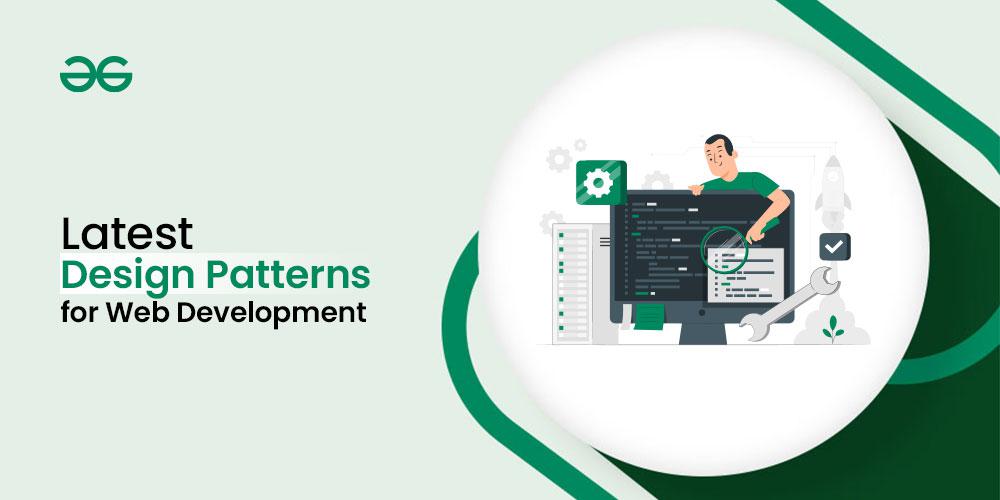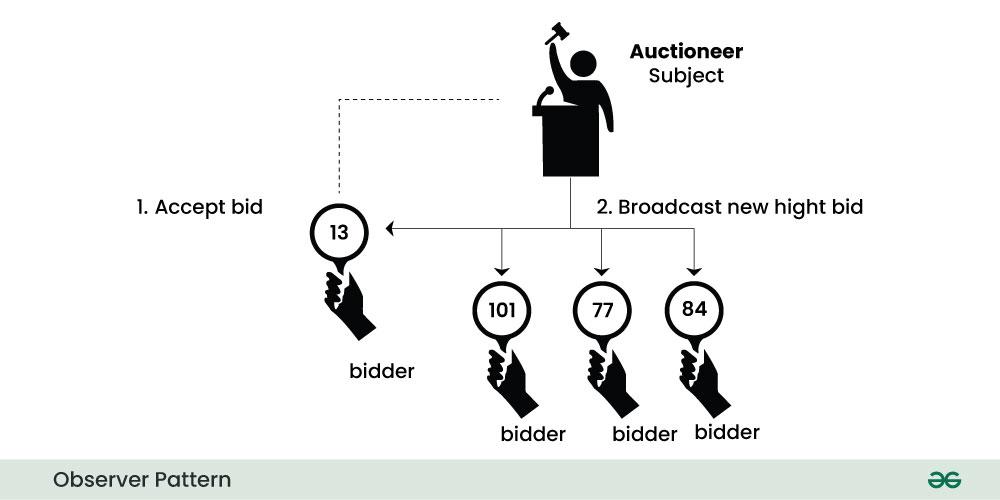
Design patterns are typical solutions to common problems in software design. Rather than being a code solution, they are general concepts you can implement in your software to expect certain behavior from it. Design patterns are not specific to any programming language or technology, but they can be implemented in different ways depending on the specific technology being used.
Design patterns are used in web development to create applications that are maintainable, efficient, and scalable. They provide a way to structure code and data in a way that is both easy to understand and maintain.

Important Topics for the Latest Design Patterns for Web Development
There are 3 types of design patterns depending on their behavior.
The Model-View-Controller (MVC) pattern is a software architecture pattern that separates an application into three parts: the model, the view, and the controller. The model is responsible for managing the data, the view is responsible for displaying the data, and the controller is responsible for handling user input and updating the model and view accordingly. This pattern promotes the separation of concerns and improves code organization.
Although this Design Pattern was originally used for desktop applications, it has become increasingly popular for all sorts of web applications as it helps to easily build the application design.
Example: Popular web frameworks like Ruby on Rails and Laravel utilize the MVC pattern.
.jpg)
The MVC pattern helps you break up the frontend and backend code into separate components. This way, it’s much easier to manage and make changes to either side without them interfering with each other.
The Model-View-Presenter (MVP) design pattern is a derivation of the Model-View-Controller (MVC) architectural pattern, and is used mostly for building user interfaces.
The MVP pattern is a UI presentation pattern based on the concepts of the MVC pattern. However, it doesn’t specify how to structure the whole system. It only dictates how to structure the view.This pattern separates responsibilities across four components in general. Firstly the view is responsible for rendering UI elements. Secondly, the view interface is used to loosely couple the presenter from its view.
Finally, the presenter interacts with the view and model, and the model is responsible for business behaviors and state management. MVP is a user interface architectural pattern engineered to facilitate automated unit testing and improve the separation of concerns in presentation logic.
This pattern divides an application into three major aspects: Model , View , and Presenter .
MVVM pattern supports two-way data binding between View and View-Model. This allows automatic propagation of changes, inside the state of View-Model to the View. Generally, the View-Model utilizes the observer pattern to inform changes in the View-Model to the Model.
MVVM (Model- View- ViewModel) is separated into three components:
The bi-directional data binding or the two way data binding between the view and the View-Model ensures that the models and properties in the View-Model is in sync with the view. The MVVM design pattern is well suited in applications that need support for bi-directional data binding.
Singleton is a creational design pattern that ensures only a single instance of a class exists throughout an application and provides access to that instance from anywhere in the codebase. It is useful in situations where multiple instances of a class are undesirable or a single point of control or coordination is required. Typical examples include logging systems, database connection managers, caches, and thread pools, among others.
Real-world examples of Singleton Design Pattern
In object-oriented programming, the Factory Method is a Creational Design Pattern that allows us to create objects without specifying the exact class that will be instantiated. Instead of creating objects directly, we use a factory method to create and return them.
This Design Pattern promotes code reuse and loose coupling between classes making our code more modular and easier to maintain. It enables us to create objects without knowing the implementation details of our classes.
Example: Creating different types of payment gateways in an e-commerce application using the Factory pattern.
The Factory Method pattern consists of four main components:
The Product is the interface or abstract class that defines the methods that the ConcreteProduct must implement. The ConcreteProduct is the class that implements the Product interface. The Creator is the abstract class that declares the Factory Method. The ConcreteCreator is the class that implements the Factory Method and returns the ConcreteProduct.
A Decorator Pattern says that just “attach a flexible additional responsibilities to an object dynamically”. In other words, The Decorator Pattern uses composition instead of inheritance to extend the functionality of an object at runtime. Decorator pattern allows a user to add new functionality to an existing object without altering its structure. This type of design pattern comes under structural pattern as this pattern acts as a wrapper to existing class.This pattern creates a decorator class which wraps the original class and provides additional functionality keeping class methods signature intact.
Example:
Adding logging functionality to specific methods of a web service using the Decorator pattern.
Observer pattern is used when there is one-to-many relationship between objects such as if one object is modified, its depenedent objects are to be notified automatically. Observer pattern falls under behavioral pattern category. Observer pattern uses three actor classes. Subject , Observer and Client . Subject is an object having methods to attach and detach observers to a client object. We have created an abstract class Observer and a concrete class Subject that is extending class Observer.
Example:
Implementing real-time notifications in a chat application using the Observer pattern.
The Observer defines a one-to-many relationship so that when one object changes state, the others are notified and updated automatically. Some auctions demonstrate this pattern. Each bidder possesses a numbered paddle that is used to indicate a bid. The auctioneer starts the bidding, and “observes” when a paddle is raised to accept the bid. The acceptance of the bid changes the bid price which is broadcast to all of the bidders in the form of a new bid.

Adapter pattern works as a bridge between two incompatible interfaces. This type of design pattern comes under structural pattern as this pattern combines the capability of two independent interfaces. This pattern involves a single class which is responsible to join functionalities of independent or incompatible interfaces. A real life example could be a case of card reader which acts as an adapter between memory card and a laptop. You plugin the memory card into card reader and card reader into the laptop so that memory card can be read via laptop.
In design, adapters are used when we have a class (Client) expecting some type of object and we have an object (Adaptee) offering the same features but exposing a different interface
To use an adapter:
The adapter pattern convert the interface of a class into another interface clients expect. Adapter lets classes work together that couldn’t otherwise because of incompatible interfaces.
Dependency Injection is a software design pattern in which one or more dependencies (or services) are injected, or passed by reference, into a dependent object (or client) and are made part of the client’s state. The pattern separates the creation of a client’s dependencies from its own behavior, which allows program designs to be loosely coupled and to follow the inversion of control and single responsibility principles.
When to use Dependency Injection Pattern:
The Repository Pattern is a design pattern used in software development that provides a way to manage data access logic in a centralized location. It separates the logic that retrieves the data and maps it to the entity model from the business logic that operates on the model. The primary objective of the Repository Pattern is to simplify the data access code and achieve a cleaner architecture for the application.
The Repository Pattern consists of three main components:
The Strategy pattern encapsulates interchangeable algorithms within separate classes, allowing clients to select the desired algorithm at runtime. This pattern promotes flexibility and code reusability, as it enables the easy addition or modification of algorithms without impacting the client code.
Example:
Implementing different payment strategies (credit card, PayPal, etc.) in an online payment processing system using the Strategy pattern.
Command pattern is a data driven design pattern and falls under behavioral pattern category. A request is wrapped under an object as command and passed to invoker object. Invoker object looks for the appropriate object which can handle this command and passes the command to the corresponding object which executes the command. In command pattern there is a Command object that encapsulates a request by binding together a set of actions on a specific receiver. It does so by exposing just one method execute() that causes some actions to be invoked on the receiver.
When to use Command Pattern:
1. Assume a front-end team responsible for creating UI (User Interface) components such as button, dropdown, checkbox, etc. These components can then be used to build UI for any application.
For example:
The button component can be used in a calculator application.
2. The frontend team is unaware of the action that will be executed when a button is clicked. It is up to the application team to decide what action will be executed when a button is clicked. This is where the command design pattern comes in. With command design pattern, the executor of the command (button component) does not need to know anything about the command being executed. So, any action can be attached to a button component.
For example:
Execute add operation when + button is clicked and execute subtract operation when- butting is clicked. We implement command design pattern by creating separate command classes.
The Middleware pattern makes it possible for components to interact with each other through a central point: the mediator. Instead of directly talking to each other, the mediator receives the requests, and sends them forward! In JavaScript, the mediator is often nothing more than an object literal or a function.
Instead of letting every objects talk directly to the other objects, resulting in a many-to-many relationship, the object’s requests get handled by the mediator. The Middleware processes this request, and sends it forward to where it needs to be.
The concept of caching is to temporarily store data that makes accessing it faster. Caching is employed to help save on the use of resources. When we retrieve data, it should be made available for future requests for the same data. Implementing this saves on the processing time required for continual retrieval of the same data.
Here are some of the commonly used caching patterns.
The front controller design pattern means that all requests that come for a resource in an application will be handled by a single handler and then dispatched to the appropriate handler for that type of request. The front controller may use other helpers to achieve the dispatching mechanism.